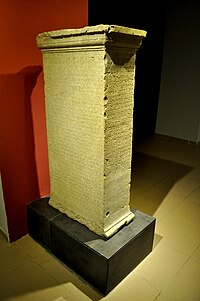
Back الآرامية الإمبراطورية Arabic Reichsaramäisch German Bahasa Aram Kekaisaran ID 帝国アラム語 Japanese Reo Emepaea Aramaic Maori
| Imperial Aramaic | |
|---|---|
| Official/Standard Aramaic | |
 | |
| Region | Ancient Near East |
| Era | c. 700–300 BC, evolved into Biblical Aramaic then split into Middle Aramaic (c. 200–1200), or Old Syriac then Classical Syriac |
Early form | |
| Aramaic alphabet | |
| Language codes | |
| ISO 639-2 | arc |
| ISO 639-3 | arc |
| Glottolog | impe1235 |
Imperial Aramaic is a linguistic term, coined by modern scholars in order to designate a specific historical variety of Aramaic language. The term is polysemic, with two distinctive meanings, wider (sociolinguistic) and narrower (dialectological). Since most surviving examples of the language have been found in Egypt, the language is also referred to as Egyptian Aramaic.[1]
Some scholars use the term as a designation for a distinctive, socially prominent phase in the history of Aramaic language, that lasted from the middle of the 8th century BCE to the end of the 4th century BCE and was marked by the use of Aramaic as a language of public life and administration in the late Neo-Assyrian Empire and its successor states, the Neo-Babylonian Empire and the Achaemenid Empire, also adding to that some later (Post-Imperial) uses that persisted throughout the early Hellenistic period. Other scholars use the term Imperial Aramaic in a narrower sense, reduced only to the Achaemenid period, basing that reduction on several strictly linguistic distinctions between the previous (Neo-Assyrian and Neo-Babylonian) phase and later (more prominent) Achaemenid phase.
Since all of those phases can be semantically labelled as "imperial", some scholars opt for the use of more specific and unambiguous terms, like Neo-Assyrian Aramaic and Neo-Babylonian Aramaic (for the older phases), and Achaemenid Aramaic (for the later phase), thus avoiding the use of the polysemic "imperial" label, and its primarily sociolinguistic implications. Similar issues have arisen in relation to the uses of some alternative terms, like Official Aramaic or Standard Aramaic, that were also criticized as unspecific. All of those terms continue to be used differently by scholars.[2][3][4][5][6][7]
The Elephantine papyri and ostraca, as well as other Egyptian texts, are the largest group of extant records in the language, collected in the standard Textbook of Aramaic Documents from Ancient Egypt.[1] Outside of Egypt, most texts are known from stone or pottery inscriptions spread across a wide geographic area.[1] More recently a group of leather and wooden documents were found in Bactria, known as the Bactria Aramaic documents.[1]
- ^ a b c d Cook, Edward (2022). Biblical Aramaic and Related Dialects: An Introduction. Cambridge University Press. p. 3-7. ISBN 978-1-108-78788-8.
Imperial Aramaic (IA) [Footnote: Other names: Official Aramaic, Reichsaramäisch. Because many of the surviving texts come from Egypt, some scholars speak of "Egyptian Aramaic."]… As noted, the documentation of IA is significantly greater than that of Old Aramaic; the hot and dry climate of Egypt has been particularly favorable to the preservation of antiquities, including Aramaic texts written on soft media such as papyrus or leather. The primary, although not exclusive, source of our knowledge of Persian-period Aramaic is a large number of papyri discovered on the island of Elephantine… All of the Egyptian Aramaic texts have been collected and reedited in the Textbook of Aramaic Documents from Ancient Egypt… This is now the standard text edition… Outside of Egypt, Aramaic texts written primarily on hard media such as stone or pottery have been discovered, including texts from Palestine, Arabia, Asia Minor, Iraq (Babylon), and Iran (Persepolis). A recent discovery, of uncertain provenance, is a relatively large collection of documents, now in a private collection, consisting mainly of the correspondence of the official Akhvamazda of Bactria dating from 354 to 324 BCE (Nave & Shaked 2012). They are similar in some ways to the Arshama archive published by Driver; the find-spot was no doubt Afghanistan.
- ^ Beyer 1986, p. 10-11.
- ^ Fitzmyer 1997, p. 59.
- ^ Folmer 1995, p. 8-13.
- ^ Gzella 2012a, p. 574.
- ^ Folmer 2012, p. 587-588.
- ^ Gzella 2015, p. 54, 105, 155, 158.